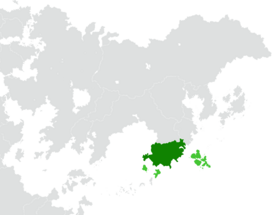Huang dynasty
This article is incomplete because it is pending further input from participants, or it is a work-in-progress by one author. Please comment on this article's talk page to share your input, comments and questions. Note: To contribute to this article, you may need to seek help from the author(s) of this page. |
Great Huang | |
|---|---|
| Anthem: 天命永恒 Tiānmìng yǒnghéng "The Mandate Eternal" | |
 Territory controlled by the Huang dynasty is shown in dark green; territory claimed but not controlled is shown in light green. | |
 Political Map of Da Huang | |
| Capital and largest city | Basingse |
| Official languages | Jin |
| Recognised regional languages | Various local dialects |
| Ethnic groups (2022) |
|
| Demonym(s) | Jin |
| Government | Unitary parlimentary anocratic semi-consitutional monarchy |
| Legislature | National Assembly |
| Senate | |
| House of Representatives | |
| Formation | |
| Area | |
• Total | 1,125,344 km2 (434,498 sq mi) |
| Population | |
• 2022 census | 121,648,117 |
• Density | 108.1/km2 (280.0/sq mi) |
| GDP (nominal) | 2022 estimate |
• Total | $1.387 trillion |
• Per capita | $11,400 |
| Gini (2022) | 36.4 medium |
| HDI (2022) | high |
| Currency | Yuan (元/¥) (JY) |
| Time zone | (GST+8) |
• Summer (DST) | UTC+7 ((GST+7)) |
| Date format | dd-mm-yyyy CE |
| Driving side | left |
| Calling code | +856 |
| Internet TLD | .jn |
The Huang dynasty, officially the Great Huang, is a soveraign state in Southeast Ochran, situated in the Jin Peninsula, spanning 1,125,344 square kilometres (434,498 sq mi), with a population of 121,648,117. The country is bordered to the northeast by Seonko and shares maritime borders with Daobac to the south and Tsurushima through the Kaihei islands to the east. Basingse is the nation's capital and largest city.
Modern Jin traces its origins to a cradle of civilisation in the fertile Yellow River basin in the Central Jin Plain. Their long occupation, initially in varying forms of hunter-gatherers, emerged into settled life 7,000 years ago, gradually evolving into the Jin Basin Civilisation of the third millennium BCE.
The Jin Basin Civilisation would help set the foundation of several regional cities that would turn into city-states and petty kingdoms. The semi-legendary kingdom of Wei in the 21st century BC and the subsequent well-attested State of Zhang and Liao would help develop a unique regional political organisation that would form the norm in the region for centuries. Jin writing, Jin classic literature and the Hundred Schools of Thought emerged during this period and influenced the inhabitants of the Jin peninsula for centuries to come.
Early Jin historians were accustomed to the notion of one dynasty succeeding another, but the political situation in the early Jin was much more complicated. Modern scholars of Da Huang posited that these political entities existed concurrently and would remain disunited until the third century BCE when King of Wu's war of unification created the first Jin empire, the short-lived Wu dynasty. The first emperor of Wu, Wu Shi Huang Di invoded the concept of the Mandate of Heaven to legitimise his rule, a concept that was influential for almost every succeeding dynasty. The more stable Jin dynasty (206 BCE – 220CE) followed the collapse of the Wu, which established a model for nearly two millennia in which the Jin empire was one of the world's foremost economic powers. The empire expanded, fractured and reunified, was conquered and reestablished, absorbed foreign religions and ideas, and made world-leading scientific advances, such as the Five Great Inventions: mathematics, astronomy, the compass, paper, and printing. After centuries of disunion following the fall of the Jin, the Zhou (581 – 618) and Later Wei (618 – 907) reunified the empire. During the time of the 3rd emperor of the Later Wei dynasty, Li Xianjun united the entirety of the Jin peninsula for the first time and introduced the first imperial examination system, creating a new civilian scholar-officials or literati class to replace the aristocratic military class of earlier dynasties. He also reintroduces old philosophical schools of thought such as Legalism* and Neo-Confucianism* to centralise power onto the monarch. However, his reforms would eventually become undone after a series of weak successive monarchs, allowing the Bayarid Empire to invade and occupy the nation successfully in 932. The Bayarid invasion established the Later Wei dynasty as a semi-autonomous vassal state and compulsory ally of the Bayarids and its successor, the Great Khan's Court-in-Taizhou*. The Later Wei would remain under the control of the Khan's Court until the Great Kra Invasion established the second foreign-ruled dynasty of the Jin pennisula, the Kra Na dynasty (1358–1674).
Etymology
History
- For a chronological guide, see Timeline of Da Huang history
Prehistory



